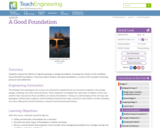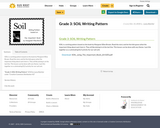
This site offers a fun guide to gardening for kids.
- Subject:
- Science
- Material Type:
- Activity/Lab
- Homework/Assignment
- Author:
- University of Illinois
- Date Added:
- 03/26/2020

This site offers a fun guide to gardening for kids.

With prior knowledge of food and organic matter decomposition, students will use industry and extension publications to learn the processes of composting, as well as the benefits and challenges of compost production (available nutrient levels, community perceptions, hazardous materials, smell, and storage).

Students will learn about issues concerning soil and water and how farmers use science to help conserve these resources.

Saline soils are a major soil issue. In this video, we discuss how saline soils reduce plant productivity and what crops preform better in saline soils.

Students pretend they are agricultural engineers during the colonial period and design a miniature plow that cuts through a "field" of soil. They are introduced to the engineering design process and learn of several famous historical figures who contributed to plow design.

Students learn how the process of soil solarization is used to pasteurize agricultural fields before planting crops. Soil solarization is a pest control technique in agriculture that uses the sun’s radiation to heat the soil and eliminate unwanted pests that could harm the crops. The approach is compared to other pest control methods such as fumigation and herbicide application, highlighting the respective benefits and drawbacks. In preparation for the associated hands-on activity on soil biosolarization, students learn how changing the variables involved in the solarizing process (such as the tarp material, soil water content and addition of organic matter) impacts the technique’s effectiveness. A PowerPoint® presentation and pre/post-quiz is provided.

Students will conduct a laboratory exercise that will examine the decomposition of organic household wastes from their home, and investigate which waste products can be composted and best utilized by plants.

This is lesson 3 of 4. Students will be creating an app for cell phones that will provide farmers with the opportunity to learn how different irrigation methods work depending on soil type.

Students design and conduct experiments to determine what environmental factors favor decomposition by soil microbes. They use chunks of carrots for the materials to be decomposed, and their experiments are carried out in plastic bags filled with dirt. Every few days students remove the carrots from the dirt and weigh them. Depending on the experimental conditions, after a few weeks most of the carrots will have decomposed completely.

Use these free activities to help kids explore our planet, learn about global challenges, think of solutions, and take action.

Students learn about water erosion through an experimental process in which small-scale buildings are placed along a simulated riverbank to experience a range of flooding conditions. They learn how soil conditions are important to the stability or failure of civil engineering projects and how a river's turns and bends (curvature, sinuosity) make a difference in the likelihood of erosion. They make model buildings either with a 3D printer or with LEGO® pieces and then see how their designs and riverbank placements are impacted by slow (laminar) and fast (turbulent) water flow over the soil. Students make predictions, observations and conclusions about the stability of their model houses, and develop ideas for how to mitigate damage in civil engineering projects.

Students learn about fossils what they are, how they are formed, and why scientists and engineers care about them.

FarmBeats, a new agriculture research project developed by Microsoft, uses solar-powered white space-based Internet connectivity to record soil temperature and moisture levels and track them with cloud-based computing models. FarmBeats enables data-driven farming in remote areas by using inexpensive monitoring equipment, including cameras, to help increase the food yield of farms.

To understand how fossils are formed, students model the process of fossilization by making fossils using small toy figures and melted chocolate. They extend their knowledge to the many ways that engineers aid in the study of fossils, including the development of tools and technologies for determining the physical and chemical properties of fossilized organisms, and how those properties tell a story of our changing world.

GeoExplore Saskatchewan is a website that will enable teachers, tourists and anyone to explore the intriguing geoscientific features of Saskatchewan. This website is a digital version of the printed Geological Highway Map of Saskatchewan.
There are numerous resources, interactive maps, Geo 101 and more!
Copy and paste this url into your browser to view a webinar on how to use this resource https://resourcebank.ca/courses/geoexplore-saskatchewan-website-webinar.

Examine geo technology at this interesting site!

Students explore the effects of regional geology on bridge foundation, including the variety of soil conditions found beneath foundations. They learn about shallow and deep foundations, as well as the concepts of bearing pressure and settlement.

SOIL is a writing pattern based on the book by Margaret Wise Brown. Read the story and let the kids guess what the important thing about each item is. They all like joining in at the last line. This lesson can be done with any theme. I put this together as a culminating ELA activity for our soil unit.

The University of Saskatchewan offers this tremendous resource that promotes the richness and diversity of the sciences, nurture curiosity and innovation, and inspire students to consider a career in science, and support teachers to provide exciting educational experiences.
Check out the great collection of video and activity resources for teachers and parents to supplement and enhance Grade 3 science learning.

Student teams locate a contaminant spill in a hypothetical site by measuring the pH of soil samples. Then they predict the direction of groundwater flow using mathematical modeling. They also use the engineering design process to come up with alternative treatments for the contaminated water.